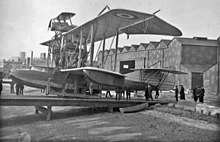Flying aircraft carrier
Flying aircraft carrier refers to an aircraft that carries one or more other aircraft and releases it at its place of use, for example a certain altitude region or above a certain location, so that it can continue to fly independently.
Realized projects

Only a few carriers of this concept were implemented. The following are known:
In 1916, John Cyrill Porte redesigned a biplane flying boat so that it could carry a Bristol Scout fighter plane on the upper wing to combat attacking airships .
On February 21, 1916, there is evidence of an accident in Great Britain in which a military airship was supposed to be used to bring a fighter plane to altitude and stay there. This was intended to repel German airship attacks. During the test to drop the two English officers Neville Usburne and Ireland with a BE2c aircraft mounted under the hull of a Seas Scout airship, suspensions tore early and the structure collapsed. Usburne was thrown from the plane, Ireland crashed with the machine. Both died.
In 1918 there were attempts in Great Britain to drop Sopwith Camel fighters from airships. The rigid airship R23 and in 1925 the R33 with a De Havilland DH.53 Humming Bird were used with attempts at coupling . In this way, the airships, which were vulnerable to enemy aircraft, were to be escorted. In 1926 tests with machines of the Gloster Grebe type followed . When the British airship industry was given up after the accident of the R101 in 1930, the construction of other Parasite Fighters was also stopped.
In Germany, too, there were tests in 1918 with the marine zeppelin L 35 / LZ 80 and an Albatros D.III . During this time tests were also carried out with torpedo gliders and various airships.
In December 1924, a Verville-Sperry M-1 Messenger docked with a US airship.
In the early 1930s, attempts began in the Soviet Union to use fixed-wing aircraft such as a special version of the Tupolev TB-3 as a carrier ( Sweno ). Combat missions followed after successful tests. However, the fighter planes carried were not used as escort fighters , but as fighter bombers . The last mission took place in 1941.
USS Akron (ZRS-4) and USS Macon (ZRS-5) were rigid airships of the United States Navy with four and five specially converted reconnaissance aircraft (including Curtiss F9C Sparrowhawk ), which could also dock with the airship. These were built in 1931 and 1933. Previously, tests with the USS Los Angeles (ZR-3) had already been carried out, with aircraft being dropped and picked up.
The Short S. 21 Maia flying boat was used with the Short S. 20 Mercury seaplane as a Short Mayo composite to bring the Mercury plane, heavily loaded as a transatlantic mail plane, to a height suitable for independent onward flight. The first flight was on July 27, 1937.

The cargo glider DFS 230 was occasionally tested in the mistletoe combination with aircraft of the types Fw 56 , Klemm Kl 35 or Bf 109 for transport to the site. However, the concept developed in 1940 did not become operational.
Fictional projects
In some fictional works, the concept of flying aircraft carriers is implemented.
- In the Avengers film series , aircraft carriers known as helicarriers can be seen, which can fly on the principle of a vertical take-off.
- The iron vulture , a mixture of airship and propeller plane , serves the air pirates in the series Käpt'n Balu and his daring crew as a mobile base of operations .
- In the broadest sense, some spaceships meet the definition of a flying aircraft carrier because they carry smaller aircraft. Examples of this can be found in Star Trek and Star Wars , among others .
See also
Web links
- USA-plan-flying-aircraft-carrier-for-drones (Die Welt.de December 21, 2014)
Individual evidence
- ↑ a b c The Short-Mayo Scheme Recalls Experiments in the Past, published in Flight; Issue of November 11, 1937, No. 1507; Pp. 480-484; Online archive accessed on October 9, 2016
- ↑ https://airandspace.si.edu/collection-objects/verville-sperry-m-1-messenger?object=nasm_A19580040000 , accessed on October 10, 2016

